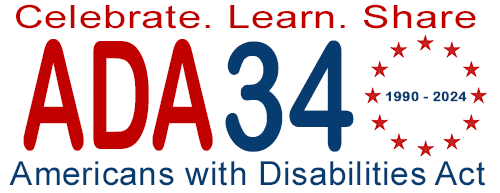On July 26, 2024, the Americans with Disabilities Act turns 34 years old.

The Americans with Disabilities Act, or ADA, is a federal civil rights law that prohibits discrimination against people with disabilities in everyday activities. In addition to that protection, the ADA also guarantees that businesses that provide goods and services to the public must do so in an accessible way. That matters to business because 18% of Americans, about one in five, have a disability. [1] They represent a huge pool of potential customers! Plus, studies show that once people with disabilities find a business where they can shop or receive services in an accessible manner, they become repeat customers. [2]
The same is true for aging Americans. According to the US Census Bureau, one in four Americans are over the age of 60. [3] They too will demand products, services, and environments that meet their age-related physical needs. Ensuring accessibility can lead to customer loyalty and revenue growth. Plus, there are real world consequences for not complying with ADA rules.
Consider these two areas of concern:
- Fines for Noncompliance
Federal law allows fines of up to $75,000 for the first violation and $150,000 for additional ADA violations.
- Damage to Your Business Reputation
Perhaps the most financially damaging consequence of not complying with the ADA is the damage to the image of a business or brand when it becomes public record that there was a serious violation under ADA laws. Providing accessible environments demonstrates that a business cares about its customers with disabilities [4].
All that being said, altering existing physical spaces to be ADA compliant costs money. Fortunately, there are two longstanding IRS tax incentives designed to make those alterations more affordable for businesses.
| A note before reading on! I’m not a CPA. If the IRS incentives below look like they would benefit your business, please work with your trusted tax professional! |
The first incentive is the Disabled Access Tax Credit (Title 26, Internal Revenue Code, Section 44). This credit was created in 1990 to help businesses comply with the ADA.
This credit is:
- Available to eligible small businesses in the amount of 50 percent of eligible access expenditures that exceed $250 but do not exceed $10,250 for a taxable year. The maximum annual credit is $5,000. This means the $250 is absorbed by the small business, but they can recoup up to $5,000 after that.
- A business may take the credit each year that it makes an eligible access expenditure.
- May be combined with the Architectural Barrier Removal Credit, which I’ll share in a moment, but only small business can claim both!
For the credit, an Eligible Small Business is defined as:
- $1 million or less in gross receipts for the preceding tax year; or
- 30 or fewer full-time employees during the preceding tax year.
- Filed with IRS Form 8826.
Now for the good part. Eligible access expenditures are amounts paid by an eligible small business to comply with the ADA. These expenditures include:
- Removing architectural, communication, physical, or transportation barriers that prevent a business from being accessible to individuals with disabilities.
- Providing qualified readers, taped texts, and other effective methods of making materials accessible to people with visual impairments.
- Providing qualified interpreters or other effective methods of making verbally delivered materials available to individuals with hearing impairments.
- Acquire or modify equipment or devices for individuals with disabilities.
This all includes things like widening doorways, installing ramps, adding extra handrails in bathrooms, or purchasing Braille signage. [5]
It can also be used for online access improvements. The Disabled Access Credit can be used for spending on the following services and solutions:
- Accessibility remediation including content and code updates.
- Targeted and comprehensive web accessibility audits
- Mobile app accessibility audits and remediation
- Accessibility training for your developers, designers, marketers, and content authors
- Remediation of PDFs
- Video closed captions and audio descriptions.
- Audio-only content transcripts [6]
Finally, use of the credit also includes expenditures a business may incur while making reasonable accommodations for their employees.
The second incentive is Architectural Barrier Removal Tax Deduction (Title 26, Internal Revenue Code, section 190). Originally passed in 1976, this tax deduction encourages businesses of any size to remove architectural and transportation barriers to the mobility of people with disabilities and the elderly. Businesses may claim a deduction of up to $15,000 a year for qualified expenses on items that normally must be capitalized.
Businesses claim this deduction by listing it as a separate expense on their income tax return. Unlike the Disabled Access Tax Credit, there is no specific form! Also, small businesses may use the Disabled Access Tax Credit and the Architectural Barrier Removal Tax Deduction together in the same tax year if the expenses meet the requirements of both sections. To use both, the deduction is equal to the difference between the total expenses and the amount of the credit claimed.
Let’s say a small business decides to improve accessibility. The business widens its doorway, adds a ramp, and upgrades its restrooms. They may take the Disabled Access Tax Credit of $5000 (based on $10,250 of expenditures), and the Architectural Barrier Removal Tax Deduction of $15,000. That’s $20,000 worth of incentives.
To receive this deduction:
- It should be claimed on the business’ income tax return for the tax year the expenses were paid.
- Identify the deduction as a separate item on the business income tax return. The election applies to all the qualifying costs the business has during the year, up to the $15,000 limit.
- If the business makes this election, it must maintain adequate records to support the deduction!
Architectural barrier removal costs that can be deducted include:
- Ground and floor surfaces
- Parking lots
- Ramps
- Entrances
- Doors and doorways
- Stairs
- Bathrooms
To be deductible, expenses of removing any barrier not covered by the above standards must meet all three of the following tests:
- The removed barrier must be a substantial barrier to access or use of a facility or public transportation vehicle by persons who have a disability or are elderly.
- The removed barrier must have been a barrier for at least one major group of persons who have a disability or are elderly (such as people who are blind, deaf or wheelchair users).
- The barrier must be removed without creating any new barrier that significantly impairs access to or use of the facility or vehicle by a major group of persons who have a disability or are elderly.
When in doubt, the main test of whether this deduction or the credit is applicable is this: “Anything put in place to enhance the accessibility of a given facility should qualify”. [7]
In conclusion, these are great financial incentives for any business to make their spaces more accessible to people with disabilities and the elderly. But as great as they are, they are highly underutilized! Very few people seem to be aware of them. In fact, the 2020 IRS Corporation Income Tax Returns Line-Item Estimates report shows only 220 8826 forms were filed, with $856,000 claimed by US businesses. [8]
But, as the saying goes, “Now you know, and knowing’s half the battle!”
Sources Cited:
[1] https://www.ada.gov/resources/title-iii-primer/
[2] ADA.gov, A Primer for Small Business, https://www.ada.gov/resources/title-iii-primer/
[3] US Census Bureau, The Older Population in The United States, 2020 https://www.census.gov/data/tables/2020/demo/age-and-sex/2020-older-population.html. The actual percentage from that report is 24.5%.
[4] https://adatile.com/what-are-the-consequences-if-your-business-is-not-ada-compliant/
[5] https://benefits.com/glossary/disabled-access-credit/
[7] Southwest ADA Center, July 11, 2024 http://southwestada.org/index.html
[8] 2020 IRS Corporation Income Tax Returns Line-Item Estimates Publication 5108 (Rev. 9-2023) (irs.gov)
Further Reading:
US EEOC Facts About Disability-Related Tax Provisions https://www.eeoc.gov/fact-sheet/facts-about-disability-related-tax-provisions
ADA Fact Sheet 4 https://archive.ada.gov/archive/taxpack.pdf
ADA.gov, A Primer for Small Business, https://www.ada.gov/resources/title-iii-primer/
ADA.gov, Introduction to the Americans with Disabilities Act, https://www.ada.gov/topics/intro-to-ada/
Why Is Accessibility Still A Problem? What Can We Do About It? (forbes.com)
EARN – Employer Tax Incentives Available from the Federal Government https://askearn.org/page/federal-government-employer-tax-incentives
IRS Business Expenses – 2022 Publication 535 (irs.gov)




